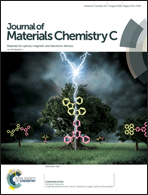Controllable synthesis and evolution mechanism of tungsten bronze nanocrystals with excellent optical performance for energy-saving glass†
Abstract
The controllable synthesis of nanocrystals with a desired structure and morphology is still a great challenge in the chemistry and materials fields. In this work, we report a simple solvothermal method for the controllable synthesis of sodium and cesium doped tungsten bronze nanocrystals (NaxCsyWO3 (NaCWO)) with different morphologies and crystalline phases, through adjusting the amounts of H+ and H2O in the reactive system. Furthermore, ethocel/NaCWO films with high transparency are also fabricated via a solution mixing method. The growth mechanisms of the NaCWO nanocrystals are investigated systematically, and structure–property relationships are also explored. Results indicate that the as-prepared two kinds of crystalline phase NaCWO nanocrystals with four morphologies can be monodispersed in toluene to form transparent nanodispersions. Among these systems, the one with rod-shaped hexagonal nanocrystals exhibits the most excellent near-infrared absorption properties, with 3.5% near-infrared transmittance at 1000 nm, and it simultaneously holds high visible light transmittance of 84% at 440 nm. Owing to the good dispersion of the nanocrystals, the ethocel/NaCWO film with an NaCWO content of 10 per hundred of ethocel resin by weight maintains the same optical performance as the nanodispersion, which is significantly important for the development of NIR absorption materials applied to energy-saving glass, solar collectors, optical filters, etc.



 Please wait while we load your content...
Please wait while we load your content...